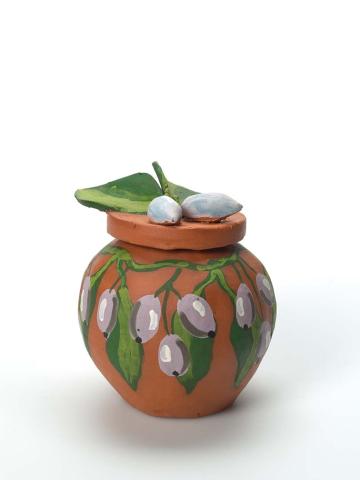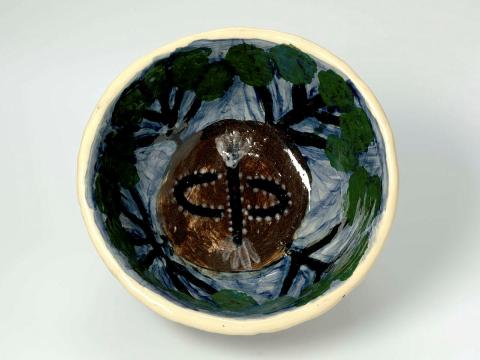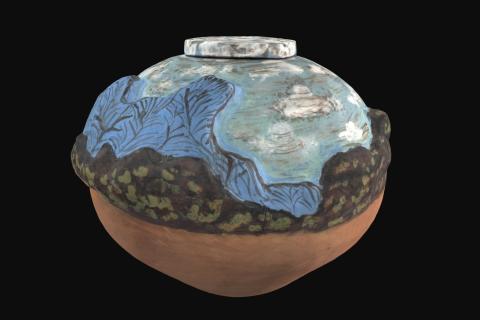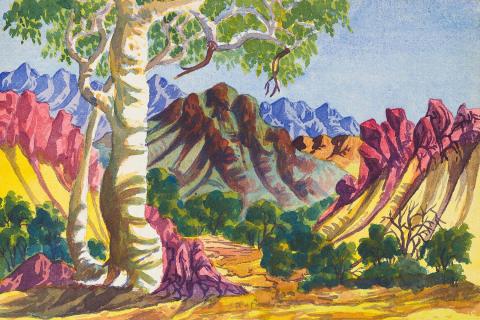QAGOMA COLLECTION: Hermannsburg Potters
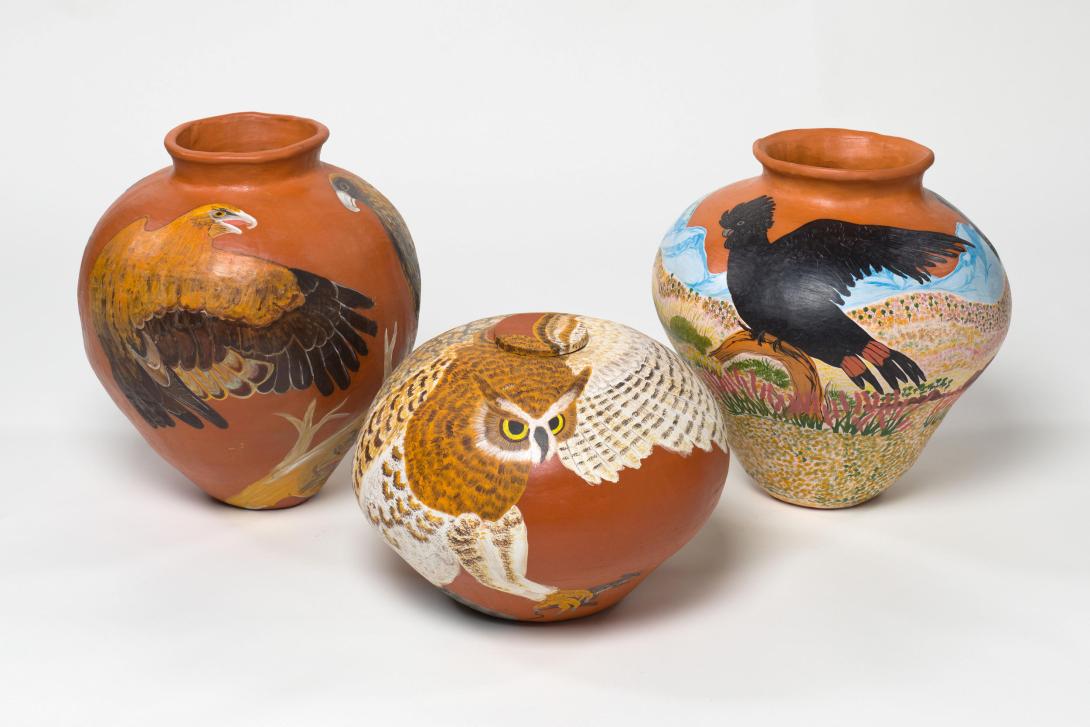
Feature image: Three earthenware pots by Hermannsburg Potters (l–r): Judith Pungkarta Inkamala’s Eeritja (Eagle) 2001; Elaine Namatjira’s Owl 1996; and Carol Rontji’s Pot: Eerarnta (Black cockatoo) 2000 / Collection: QAGOMA / © The artists / Photograph: N Harth, QAGOMA
Ntaria is a former Lutheran mission some 130 kilometres west of Alice Springs, now home to the Hermannsburg Potters. The Arrernte (Aranda) people from this area – inspired by the example of their forebear, renowned painter Albert Namatjira (1902–59) – are famous for their watercolours of the desert interior of Australia.
When the Arrernte community took over responsibility for the mission in 1982, Pastor Nahasson Ungwanaka (a key figure in the Hermannsburg community and husband of potter Rahel Ungwanaka) sought to establish social and economic ventures for his people. Although he had some experience with modelling clay figures in the early 1960s, he lobbied for more formal instruction in ceramics. This resulted in the 1990 appointment of Naomi Sharp, a teacher from the Northern Territory Open College of TAFE, and the subsequent establishment of the Hermannsburg Pottery.
Writer Jennifer Isaacs has noted that the late north Queensland potter Thanakupi:
. . . offered an example of an Aboriginal woman from a traditional background who had been able, through her craft of clay, to create a life for herself and live independently as an Indigenous person in Australia.
As pottery-making is not a traditional practice for Aboriginal people, Hermannsburg’s women potters view their work as an avenue for self-expression – the richly decorated, full-bodied vessels document their history and their day-to-day lives. This vibrant, handmade pottery and, in more recent years, paintings on canvas have been exhibited to wide acclaim nationally and internationally.
Irene Mbitjana Entata

Albert Namatjira droving 2001
- HERMANNSBURG POTTERS - Pottery workshop
- ENTATA, Irene Mbitjana - Potter

Journey to Horseshoe Bend 2006
- HERMANNSBURG POTTERS - Pottery workshop
- ENTATA, Irene Mbitjana - Potter

Rex and Albert painting in Palm Valley 2001
- HERMANNSBURG POTTERS - Pottery workshop
- ENTATA, Irene Mbitjana - Potter

Pot: (Ant on climbing plant) 2002
- HERMANNSBURG POTTERS - Pottery workshop
- ENTATA, Irene Mbitjana - Potter

Pot: Cows 2000
- HERMANNSBURG POTTERS - Pottery workshop
- ENTATA, Irene Mbitjana - Potter

Pot: Footy (Lions vs Bombers) 2004
- HERMANNSBURG POTTERS - Pottery workshop
- ENTATA, Irene Mbitjana - Potter

Pot: Mission days 2005
- HERMANNSBURG POTTERS - Pottery workshop
- ENTATA, Irene Mbitjana - Potter

Pmere (My country) 1996
- HERMANNSBURG POTTERS - Pottery workshop
- ENTATA, Irene Mbitjana - Potter

Pot: Reelpa (Drovers) 2002
- HERMANNSBURG POTTERS - Pottery workshop
- ENTATA, Irene Mbitjana - Potter

Rubbing salts 2006
- HERMANNSBURG POTTERS - Pottery workshop
- ENTATA, Irene Mbitjana - Potter

The events leading to Albert's death 2001
- HERMANNSBURG POTTERS - Pottery workshop
- ENTATA, Irene Mbitjana - Potter
Noreen Ngala Hudson

Pot: Pmere Nuka (My country) 1994
- HERMANNSBURG POTTERS - Pottery workshop
- HUDSON, Noreen Ngala - Potter

Pot: Pmere Nuka (My country) 1994
- HERMANNSBURG POTTERS - Pottery workshop
- HUDSON, Noreen Ngala - Potter

Pot: Eeritja (Eagles) 1997
- HERMANNSBURG POTTERS - Pottery workshop
- HUDSON, Noreen Ngala - Potter

Pot: Lorikeets 1996
- HERMANNSBURG POTTERS - Pottery workshop
- HUDSON, Noreen Ngala - Potter
Clara Inkamala

Pot: Ilia (Emu) 2002
- INKAMALA, Clara - Potter
- HERMANNSBURG POTTERS - Pottery workshop

Ntaria Garage 2007
- INKAMALA, Clara - Potter
- HERMANNSBURG POTTERS - Pottery workshop
Judith Pungkarta Inkamala

Albert Namatjira 2017
- HERMANNSBURG POTTERS - Pottery workshop
- INKAMALA, Judith Pungkarta - Potter

Artist house 2014
- HERMANNSBURG POTTERS - Pottery workshop
- INKAMALA, Judith Pungkarta - Potter

Pink galahs at Imarlkna 2006
- HERMANNSBURG POTTERS - Pottery workshop
- INKAMALA, Judith Pungkarta - Potter

Pot: Eeritja (Eagle) 2001
- HERMANNSBURG POTTERS - Pottery workshop
- INKAMALA, Judith Pungkarta - Potter

Pot: Enalaunga (Echidna) family 2004
- HERMANNSBURG POTTERS - Pottery workshop
- INKAMALA, Judith Pungkarta - Potter

Pot: Kangaroo 1996
- HERMANNSBURG POTTERS - Pottery workshop
- INKAMALA, Judith Pungkarta - Potter
Carol Rontji

Pot: Eerarnta (Black cockatoo) 2000
- HERMANNSBURG POTTERS - Pottery workshop
- RONTJI, Carol - Potter

Tompa (Perentie) 1997
- HERMANNSBURG POTTERS - Pottery workshop
- RONTJI, Carol - Potter
Lindy Rontji

Pot: (Butterfly) 2002
- HERMANNSBURG POTTERS - Pottery workshop
- RONTJI, Lindy - Potter

Sand dunes at Papunya 2007
- HERMANNSBURG POTTERS - Pottery workshop
- RONTJI, Lindy - Potter
Rona Rubuntja

Arrkarma (bloodwood apple) (from 'Bush tucker' series) 2009
- HERMANNSBURG POTTERS - Pottery workshop
- RUBUNTJA, Rona - Potter

Katjirra (bush tomato, over-ripe) (from 'Bush tucker' series) 2009
- HERMANNSBURG POTTERS - Pottery workshop
- RUBUNTJA, Rona - Potter

Koprillia Day at Hermannsburg 2007
- HERMANNSBURG POTTERS - Pottery workshop
- RUBUNTJA, Rona - Potter

Kupaarta arnka ngrra (bush plums, ripening) (from 'Bush tucker' series) 2009
- HERMANNSBURG POTTERS - Pottery workshop
- RUBUNTJA, Rona - Potter

Kupaarta urnma (bush plums, ripe) (from 'Bush tucker' series) 2009
- HERMANNSBURG POTTERS - Pottery workshop
- RUBUNTJA, Rona - Potter

Langkwa (bush banana) (from 'Bush tucker' series) 2009
- HERMANNSBURG POTTERS - Pottery workshop
- RUBUNTJA, Rona - Potter

Latjia (pencil yam) (from 'Bush tucker' series) 2009
- HERMANNSBURG POTTERS - Pottery workshop
- RUBUNTJA, Rona - Potter

Lupa (wattle seed) (from 'Bush tucker' series) 2009
- HERMANNSBURG POTTERS - Pottery workshop
- RUBUNTJA, Rona - Potter

Mpaltjarta (wild orange) (from 'Bush tucker' series) 2009
- HERMANNSBURG POTTERS - Pottery workshop
- RUBUNTJA, Rona - Potter

Ngaraaka (bush bean) (from 'Bush tucker' series) 2009
- HERMANNSBURG POTTERS - Pottery workshop
- RUBUNTJA, Rona - Potter

Paraltja lerop (red river gum leaf) (from 'Bush tucker' series) 2009
- HERMANNSBURG POTTERS - Pottery workshop
- RUBUNTJA, Rona - Potter

Pmurlpa (quondong) (from 'Bush tucker' series) 2009
- HERMANNSBURG POTTERS - Pottery workshop
- RUBUNTJA, Rona - Potter

Pot: Kuparda (Bush plum) 2002
- HERMANNSBURG POTTERS - Pottery workshop
- RUBUNTJA, Rona - Potter

Rraatninga (wild passionfruit) (from 'Bush tucker' series) 2009
- HERMANNSBURG POTTERS - Pottery workshop
- RUBUNTJA, Rona - Potter

Taltjakurla (mulga apple) (from 'Bush tucker' series) 2009
- HERMANNSBURG POTTERS - Pottery workshop
- RUBUNTJA, Rona - Potter

Tjaapa tnyamaatja (witchetty grubs) (from 'Bush tucker' series) 2009
- HERMANNSBURG POTTERS - Pottery workshop
- RUBUNTJA, Rona - Potter

Tjankana (mistletoe berry) (from 'Bush tucker' series) 2009
- HERMANNSBURG POTTERS - Pottery workshop
- RUBUNTJA, Rona - Potter

Tjurka (bush fig) (from 'Bush tucker' series) 2009
- HERMANNSBURG POTTERS - Pottery workshop
- RUBUNTJA, Rona - Potter

Urrarlpa (native tomato in hilly habitats) (from 'Bush tucker' series) 2009
- HERMANNSBURG POTTERS - Pottery workshop
- RUBUNTJA, Rona - Potter

Yalka (wild onion) (from 'Bush tucker' series) 2009
- HERMANNSBURG POTTERS - Pottery workshop
- RUBUNTJA, Rona - Potter

Yirrampa (honey ant) (from 'Bush tucker' series) 2009
- HERMANNSBURG POTTERS - Pottery workshop
- RUBUNTJA, Rona - Potter
Rahel Ungwanaka

Ankarta (Frill-necked lizard) 2005
- HERMANNSBURG POTTERS - Pottery workshop
- UNGWANAKA, Rahel - Potter

Owl 2005
- HERMANNSBURG POTTERS - Pottery workshop
- UNGWANAKA, Rahel - Potter

Pot: Kookaburras 2004
- HERMANNSBURG POTTERS - Pottery workshop
- UNGWANAKA, Rahel - Potter

Pot: Tompa (Perentie) 2002
- HERMANNSBURG POTTERS - Pottery workshop
- UNGWANAKA, Rahel - Potter
Other Hermannsburg potters

Owl 1996
- HERMANNSBURG POTTERS - Pottery workshop
- NAMATJIRA, Elaine - Potter

Pot: (Bush orange) 2002
- HERMANNSBURG POTTERS - Pottery workshop
- KENNEDY, Esther - Potter
Explore the Hermannsburg School

Digital Story Introduction
THE HERMANNSBURG SCHOOLQAGOMA COLLECTION: Hermannsburg painters
Read digital storyDigital story context and navigation
THE HERMANNSBURG SCHOOLExplore the story

Digital Story Introduction
THE HERMANNSBURG SCHOOLQAGOMA COLLECTION: Hermannsburg painters
Read digital story
Digital Story Introduction
THE HERMANNSBURG SCHOOLQAGOMA COLLECTION: Hermannsburg Potters
Read digital story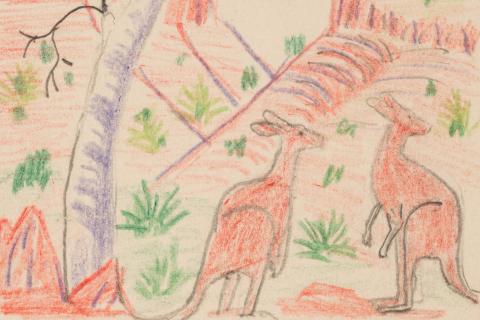
Digital Story Introduction
THE HERMANNSBURG SCHOOLOswald A Wallent Collection of Hermannsburg Material
Read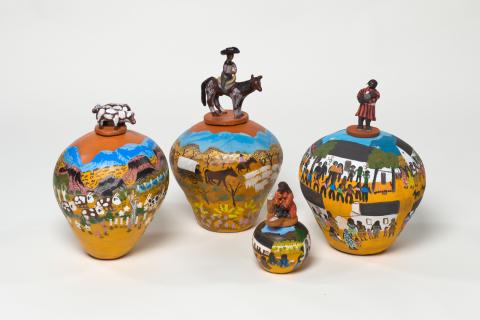
Ingkwia Tjaiya, Lyaartinya Tjaiya (Old Way, New Way)
Read ESSAYAbout this page
Related resources
